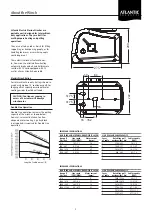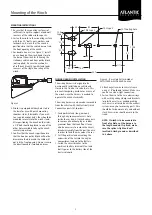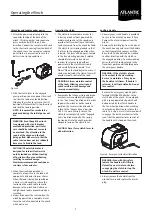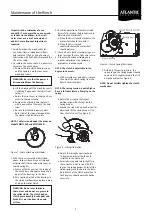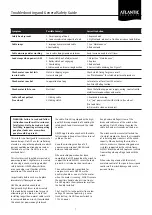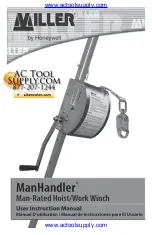
Troubleshooting and General Safety Guide
Symptom
Possible Cause(s)
Corrective Action
Safety hook spreads
1. Point loading of hook
2. Load exceeds rated capacity of unit
1.Replace hook
2. Lighten load, reduce % of incline or reduce load friction
Cable snaps
1. Improperly maintained cable
2.Overloading
1. See “Maintenance”
2. Reduce load
Cable miswrap and/or crushing
Loose cable being wound onto drum
Keep tension on cable at all times
Load creeps when power is OFF
1. Brake/clutch out of adjustment
2. Roller clutch not engaging
3. Overloading
4.Cable wound on drum wrong direction
1. Adjust(see “Maintenance”)
2. Replace
3. Reduce load
4. Correct cable winding (See Figure 7)
Winch motor runs but fails
to wind cable
Clutch is slipping or gear
train is damaged
Check clutch lining for grease or oil.
See “Maintenance” for clutch adjustment procedure
Winch motor runs hot
In operation too long
Let motor cool for at least 20 minutes
(See Winch Rating Section)
Winch motor fails to run
Electrical
Check the following: power supply, wiring, control switch,
male/female connections and motor
Cable will not pull out
(free wheel)
1.Sticking cable
2.Sticking clutch
1.Avoid cable miswrap
2. a) “Jop” power switch with clutch in free wheel
(No Load Only)
b) Dissemble, clean and readjust
WARNING: Failure to read and follow
instructions could result in serious or
fatal injury. Not to be used as a hoist
for lifting, supporting or transporting
people or loads over areas where
people could be present.
This winch is not designed for movement of
human beings. Do NOT use for scaffolding,
elevators, or any other application in which
persons could be positioned on or under
the load at any time. Do NOT use as an
overhead hoist.
This electric winch should be respected as
power equipment. High forces are created
when using a winch, creating potential
safety hazards. NEVER allow children
or anyone who is not familiar with the
operation of the winch to use it.
Inspect cable before each use. Replace
immediately if damaged or worn.
NEVER exceed rated winch load.
Dangerously high forces can be created
if the load being moved is too large or is
allowed to get in a bind, etc. Note that
installing longer than normal cable results
in increased load on winch. If overloaded
this winch has power enough to break
the cable. Winch is equipped with a high-
quality fibre rope capable of handling the
rated winch load. Never exceed the rated
capacity.
NEVER apply load to winch with the cable
fully extended. Keep at least three turns of
cable on the reel.
Keep the winching area free of all
unnecessary personnel. NEVER stand
between load and winch.
When winching operation has been
completed, do NOT depend on the winch to
support the load. ALWAYS secure the load
properly. Use tie-down straps or chains.
The auxiliary handle is provided for
emergency use only. NEVER use the
auxiliary handle as an assist to the motor
when the motor is running. ALWAYS remove
the auxiliary handle when ti is not in use.
Do NOT operate the winch motor or allow
the handle installed.
The 12 volt DC winch operates from a low
voltage DC source of power(e.g.,a car or
truck battery).Do NOT connect winch to
115V AC power.
Keep hands and fingers clear of the
drum and cable area of the winch when
operating. Do NOT attempt to guide the
cable by hand as it rewinds on the drum.
The winch must be securely attached to a
structural member or frame that is capable
of sustaining loads in excess of the winch
capacity. When attaching the winch to a
vehicle, make sure the mounting pad area
is rigidly supported by the vehicle frame.
ALWAYS block the wheels to prevent vehicle
from rolling when pulling a load with the
winch.
When releasing a load with the clutch,
maintain control of the speed. Excess speed
could result in winch damage and severe
personal injury.
7


